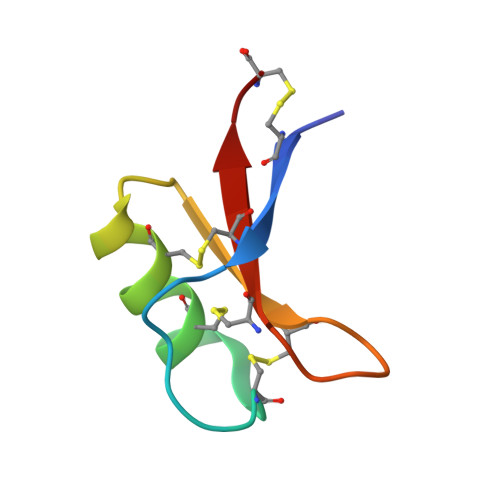Phosphoinositide-Mediated Oligomerization of a Defensin Induces Cell Lysis.
Poon, I.K.H., Baxter, A.A., Lay, F.T., Mills, G.D., Adda, C.G., Payne, J.A., Phan, T.K., Ryan, G.F., White, J.A., Veneer, P.K., Van Der Weerden, N.L., Anderson, M.A., Kvansakul, M., Hulett, M.D.(2014) Elife 3: 1808
- PubMed: 24692446
- DOI: https://doi.org/10.7554/eLife.01808
- Primary Citation of Related Structures:
4CQK - PubMed Abstract:
Cationic antimicrobial peptides (CAPs) such as defensins are ubiquitously found innate immune molecules that often exhibit broad activity against microbial pathogens and mammalian tumor cells. Many CAPs act at the plasma membrane of cells leading to membrane destabilization and permeabilization. In this study, we describe a novel cell lysis mechanism for fungal and tumor cells by the plant defensin NaD1 that acts via direct binding to the plasma membrane phospholipid phosphatidylinositol 4,5-bisphosphate (PIP2). We determined the crystal structure of a NaD1:PIP2 complex, revealing a striking oligomeric arrangement comprising seven dimers of NaD1 that cooperatively bind the anionic headgroups of 14 PIP2 molecules through a unique 'cationic grip' configuration. Site-directed mutagenesis of NaD1 confirms that PIP2-mediated oligomerization is important for fungal and tumor cell permeabilization. These observations identify an innate recognition system by NaD1 for direct binding of PIP2 that permeabilizes cells via a novel membrane disrupting mechanism. DOI: http://dx.doi.org/10.7554/eLife.01808.001.
Organizational Affiliation:
Department of Biochemistry, La Trobe Institute for Molecular Science, La Trobe University, Melbourne, Australia.

















